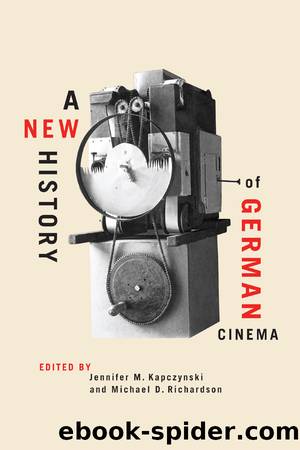A New History of German Cinema by Jennifer M. Kapczynski

Autor:Jennifer M. Kapczynski
Die sprache: eng
Format: epub
ISBN: 9781571134905
Herausgeber: Boydell & Brewer Group Ltd
veröffentlicht: 2014-02-25T00:00:00+00:00
Notes
1 âAngst vor der Wahrheit,â Tagesspiegel (9 April 1946).
2 Heinz-Gerd and Reinhard Wolf, ââIch nehmâ das alles nicht so ernst â¦â: Gespräch mit Billy Wilder,â in Billy Wilders Filme, ed. Neil Sinyard and Adrian Turner (West Berlin: Spiess, 1980), 9â51; here 48.
3 Dagmar Barnouw, Germany 1945: Views of War and Violence (Bloomington/Indianapolis: Indiana UP, 1996); Brigitte Hahn, Umerziehung durch Dokumentarfilm? Ein Instrument amerikanischer Kulturpolitik im Nachkriegsdeutschland, 1945â1953 (Münster: LIT, 1997), 113â28; and Cora Sol Goldstein, Capturing the German Eye: American Visual Propaganda in Occupied Germany (Chicago: U of Chicago P, 2009), 51â57.
4 Some misjudgments about the film are based on the false assumption that the sharp denunciations of Germans in the English-language version Death Mills were literal translations from the original German narration. However, this passage was altered in Death Mills in order to warn occupation soldiers sent to Germany after the end of the war about âfraternization.â
5 âThe Atrocity Film in Bavaria,â Information Control Intelligence Summary 30 (9 February 1946): 4â5, National Archives, College Park (NARA): RG 260/OMGUS, ICD, MPB, Box 281, Folder Film, Intelligence Reports.
6 FTM Sub-Section Report 27 (28 March 1946) NARA: RG 260/OMGBS, Records of Information Services BR, General Records 1945â49, Box 82, Folder Monthly Reports 1945â46.
7 Public Opinion Surveys Unit, âThe Atrocity Film in Berlinâ (8 April 1946), NARA: RG 260/OMGUS, ICD, MPB, Box 281, Folder Film, Intelligence Reports.
8 Most borrow the argument from Brewster S. Chamberlin, âTodesmühlen. Ein früher Versuch zur Massen-âUmerziehungâ im besetzten Deutschland 1945â1946,â Vierteljahrshefte für Zeitgeschichte 29, no. 3 (1981): 420â36.
9 Ulrike Weckel, âAmerikanischer Traum von einem deutschen Schuldbekenntnis. Der Spielfilm Judgment at Nuremberg (1961) und seine Rezeption in der deutschen Presse,â in Das Gericht als Tribunal oder: Wie der NS-Vergangenheit der Prozess gemacht wurde, ed. Georg Wamhof (Göttingen: Wallstein, 2009), 163â85.
10 Ewout van der Knaap, âEnlightening Procedures: Nacht und Nebel in Germany,â in Uncovering the Holocaust: The International Reception of Night and Fog, ed. Ewout van der Knaap (London: Wallflower, 2006), 46â85.
Download
Diese Site speichert keine Dateien auf ihrem Server. Wir indizieren und verlinken nur Inhalte von anderen Websites zur Verfügung gestellt. Wenden Sie sich an die Inhaltsanbieter, um etwaige urheberrechtlich geschützte Inhalte zu entfernen, und senden Sie uns eine E-Mail. Wir werden die entsprechenden Links oder Inhalte umgehend entfernen.
| Geschichte & Kritik |
Bob, der Streuner by James Bowen(1445)
Kaffee und Zigaretten by Schirach Ferdinand von(1360)
Der Andere by von Schirach Ferdinand(1316)
Die Biene Maja by Waldemar Bonsels(1299)
GRM (German Edition) by Sibylle Berg(1299)
Der Idiot by Fjodor Dostojewskij(1284)
Utopia by Thomas Morus(1260)
05 by Nur über meine Leiche(1184)
Die Hashimoto-Diät by Vanessa Blumhagen(1183)
Der Taubentunnel by John le Carré(1170)
Titan by Jean Paul(1169)
Der Name der Rose by Umberto Eco(1164)
Die Enden der Welt by Willemsen Roger(1151)
Oscar by David Dosa(1131)
Die elegante Hausfrau by Isa von der Lütt(1130)
Sieben Stunden im April by Susanne Preusker(1126)
Ich habe einen Namen by Hill L(1115)
Ein Geschenk von Bob [08.11.14] by James Bowen(1075)
Jeden Tag wurde ich dicker und müder: Mein Leben mit Hashimoto (German Edition) by Blumhagen Vanessa(1075)
